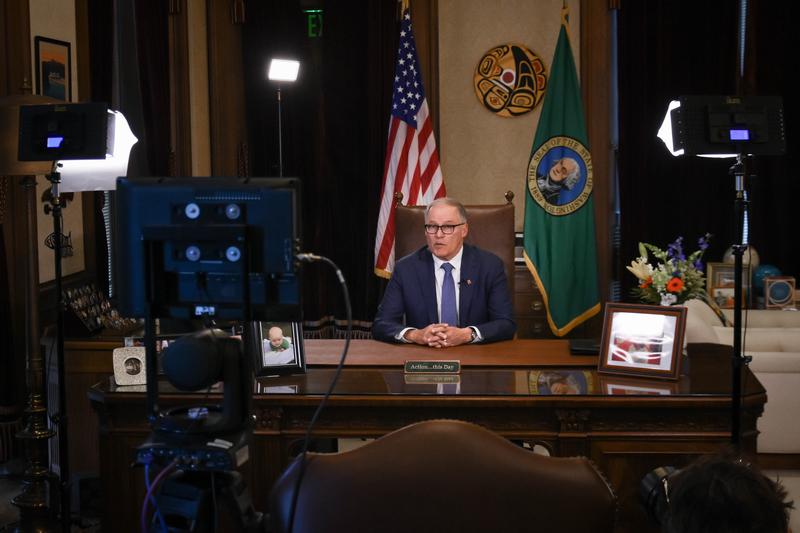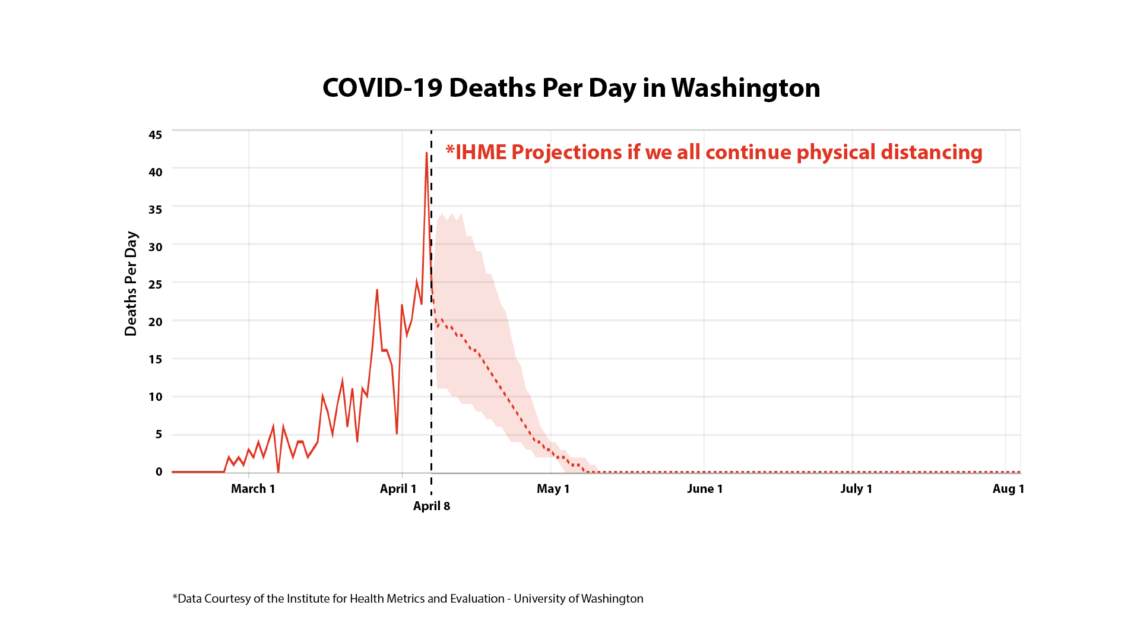
In Washington And Beyond, When Will It Start To Get Back To Normal? Experts Weigh In
Listen
After weeks of extraordinary efforts to slow the spread of the new coronavirus and prevent hospitals from being overwhelmed, Washington state officials are beginning to talk more openly about easing social distancing restrictions and a sequential unlocking of the economy.
Gov. Jay Inslee’s current “Stay Home, Stay Safe” order is set to expire on May 4 and, after weeks of imposing more restrictions on daily life and the economy, even he’s hinting that next month could bring a transition to the “second phase” of the state’s response to the global pandemic — while also cautioning that “we’re not out of the woods yet.”
“I think we will kind of do a reverse of what we did going into it,” Inslee said in a one-on-one interview with the public radio Northwest News Network. As the public health crisis mounted, Inslee first limited crowd sizes, then closed schools and then issued a statewide “stay home” order.
If phase one was marked by what Inslee calls the “dull instrument” of social distancing, phase two will represent an in-between stage where the virus remains a clear and present danger, but keeping it in check is done with “individualized smart weapons.”
ALSO SEE: Coronavirus News, Resources, Updates From NWPB
In this second phase, Inslee envisions a step-by-step relaxing of social distancing orders and allowing some non-essential businesses to reopen — and then watching to see if the virus kicks up again. Inslee described this approach as “monitor and adapt.”
But before any of the existing restrictions are lifted, state and local public health officials will want to see a sustained decline in new COVID-19 cases, hospitalizations and deaths.
“I know everyone’s asking: when are we going to do this? And ‘not yet’ is the best answer,” said Dr. Scott Lindquist, the state’s chief epidemiologist for communicable diseases.
Dr. Lindquist is not alone in advising caution. Dr. Jeff Duchin of Public Health Seattle and King County said the risk of stepping back too quickly is the virus will come raging back.
“We want to make sure that when we do start to get back to usual activities, we do it in a measured way that doesn’t lead to the health care system becoming overwhelmed,” Duchin said.
On Wednesday, the state reported 26 new deaths and 89 new cases. All told, there’ve been 567 deaths in Washington and 10,783 confirmed cases.
Current projections from the University of Washington show a sharp decline in daily deaths by May 4, presuming social distancing continues.
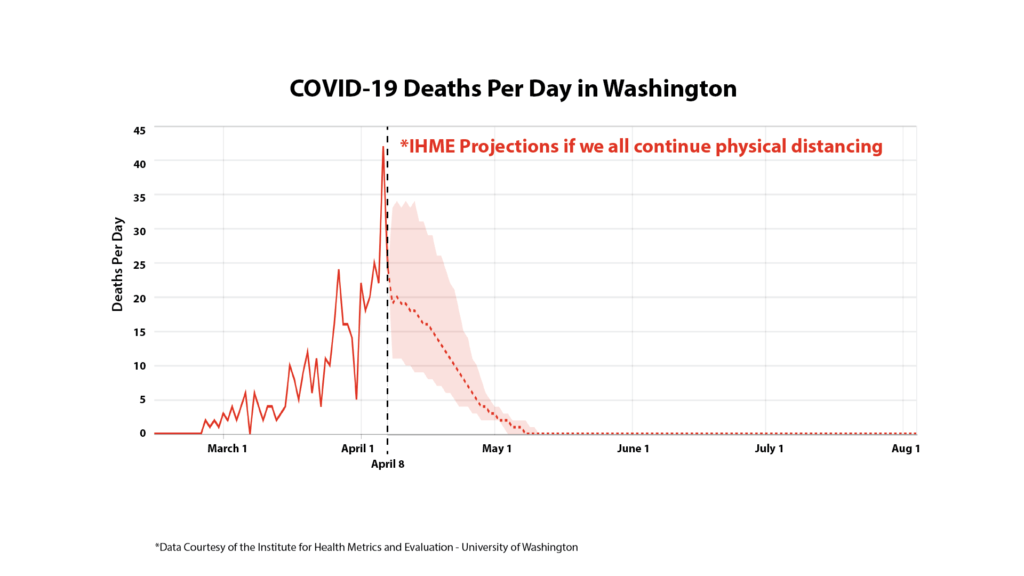
This chart from the Institute for Health Metrics and Evaluation at the University of Washington shows a sharp decline in COVID-19 related deaths by early May if social distancing practices continue. CREDIT: Office of Gov. Jay Inslee
But on Wednesday Inslee shared other modeling that suggests it may take longer to see significant declines. He also made clear that some form of social distancing is likely to extend for weeks, if not months.
Another indicator of whether the spread of the virus has been controlled is how often it’s replicating. Because COVID-19 is highly contagious and the population has no immunity, its replication rate (also known as its “r-naught”) was between two and three at the beginning, meaning one person with the virus was infecting two to three other people. Now, there’s evidence that rate has been brought to below one in King, Snohomish and Pierce Counties which were hard hit by the virus early on.
Even if public health officials are comfortable with the trend lines, there’s no guarantee the state will have the infrastructure in place by May 4 to shift from a strategy of mitigation to one of containment.
Inslee said the state is “in a race” to put in place the public health surveillance system that’s needed to make that transition.
In what Inslee described as an “ambitious goal,” the state is seeking to double its testing capacity over the next couple of weeks.
“The pace we can do that is actually the defining factor when we can loosen some of these controls,” Inslee said.
While the state has ample lab capacity, a major barrier to more widespread testing has been access to testing supplies – including swabs and the liquid transport media that’s needed to preserve the specimen. In a promising sign, this week, Washington’s Department of Health (DOH) was in the process of distributing 15,000 additional testing kits to local public health offices, something Dr. Lindquist said was not doable a couple of weeks ago.
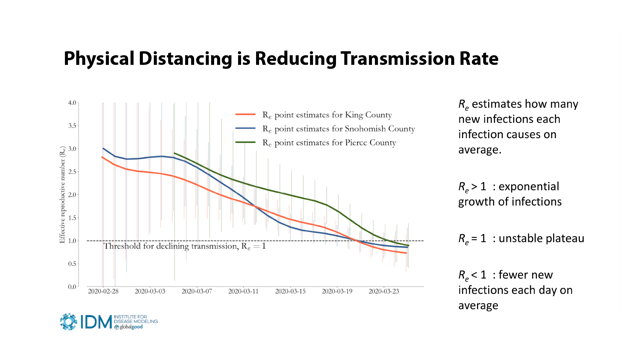
This chart from the Institute for Disease Modeling shows the reproductive rate of COVID-19 dropping below one in King, Pierce and Snohomish Counties. That’s one indication that social distancing measures are working. CREDIT: Office of Gov. Jay Inslee
In addition to robust testing, Washington needs to build its capacity to respond quickly when someone tests positive for COVID-19 and work quickly to trace their recent contacts and then quarantine those individuals. Contact tracing, as it’s called, is time consuming work. But technology could make it easier. Dr. Lindquist is intrigued by smart phone apps that could alert people if they’ve come in close contact with someone who tests positive for COVID-19.
“I’m looking at tools like this as we release the community mitigation or we loosen it, these are the things that are going to become more important,” Lindquist said.
Because of potential privacy concerns, Lindquist said the state plans to consult a team of ethicists about the use of this technology.
Even as Washington works to build a robust testing and tracing system, there’s already talk about how to restart the economy. House Republican Leader J.T. Wilcox – whose family runs Wilcox Farms – said after the blunt instrument of the “stay home” order, he wants to start using a “scalpel.”
“We should look carefully at every job category and find out what we can do to let people get back to work in a way that provides a lot less risk,” Wilcox said.
But Speaker of the House Laurie Jinkins, who works in public health, said the “worst mistake” would be to back off restrictions too quickly.
ALSO SEE: Coronavirus News, Resources, Updates From NWPB
“Our economy can withstand whatever it needs to withstand, I believe, in order to save lives,” Jinkins said. “That’s not to say that there isn’t a balance of those things.”
Jinkins and Wilcox, who have been communicating regularly, agree there are opportunities to put people back to work sooner than later. Both gave the examples of the landscaping industry where social distancing may be easier to maintain, and online auto sales.
So far, Democratic and Republican leaders in the Legislature have been united in their support of Inslee’s emergency actions. But recently there have been signs of cracks in that bipartisanship.
Minority Republicans have been pushing Inslee to allow private construction, and home building in particular, to resume. Inslee said talks are underway to do that, but he’s not committed to a timeline.
In a statement Wednesday, Senate Republican Leader Mark Schoesler criticized Inslee’s emergency order shuttering non-essential businesses as too broad, especially compared to Oregon and California. On Monday, Inslee announced a pact with those other west coast states to work together on reopening the economy and controlling COVID-19.
“Oregon’s governor closed types of businesses where social distancing is impractical or impossible, and let everyone else stay open as long as they adhere to social distancing requirements,” Schoesler said in his statement. “That’s a practical, common-sense approach that I wish our governor would use to allow more of our state’s economy to function.”
At Washington’s Department of Commerce, director Lisa Brown of Spokane has been tasked with spearheading the state’s economic recovery. She anticipates the economy will reopen industry by industry and region by region.
“We’re looking at a restart of our economy, but it will be a new normal with new kinds of guidelines and safety standards in place,” Brown predicted.
For instance, some employees might have their temperatures taken as they arrive to work and there might be new social-distancing requirements in the workplace.
But even as some people get back to work, Brown warned the economic recovery will likely take years and require a federal response on par with the New Deal.
Already, the grinding to a halt of much of the economy has produced unprecedented numbers of claims for unemployment insurance. In Washington alone, over a three week period nearly half a million workers applied for benefits.
For Inslee, who said science is driving his decisions, the looming question is when the long road to recovery can begin.
“Well, I am hopeful after May 4th there are some things that we can return to,” he said, adding quickly, “That is not a guarantee.”
Related Stories:
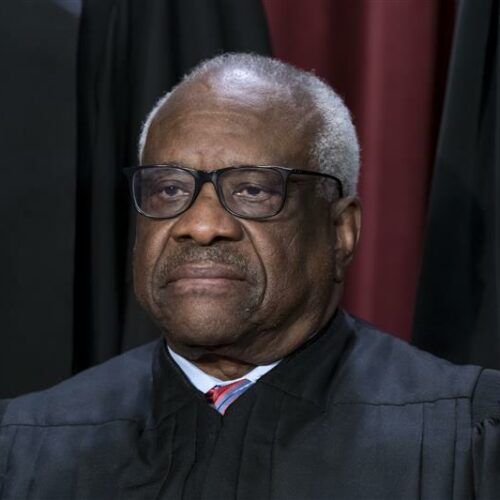
US Supreme Court will consider petition for stay in COVID-19 free speech case
The U.S. Supreme Court will review an application for a stay in a federal lawsuit involving local retired eye doctor Richard Eggleston.
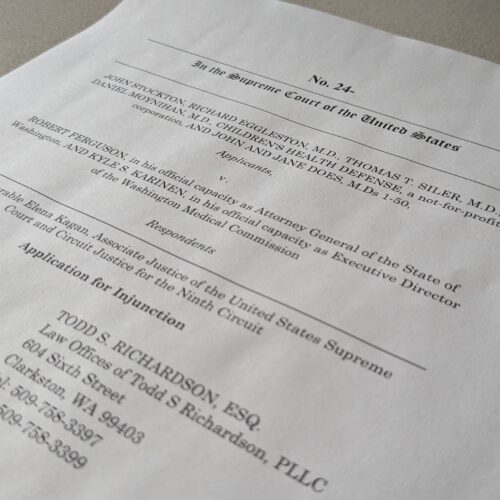
Group representing retired Clarkston ophthalmologist asks US Supreme Court for injunctive relief
A retired Clarkston eye doctor is part of a group asking the U-S Supreme Court to grant an injunction in a lawsuit against Washington state officials.
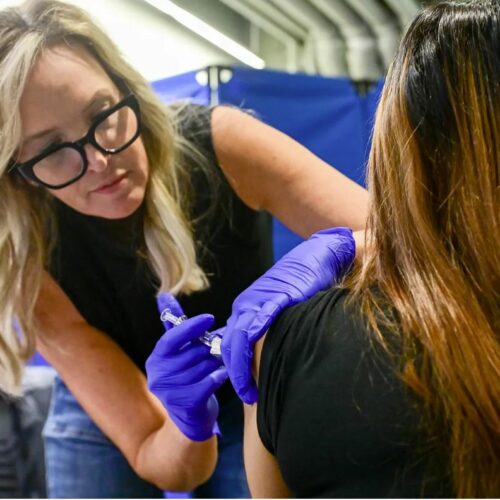
Experts say get vaccinated now for influenza
Flu season is just around the corner, and health officials say now is a great time to get your flu shot.

